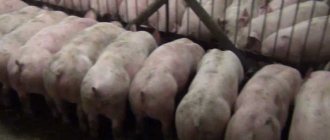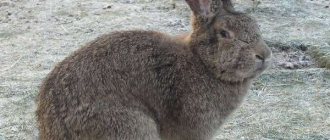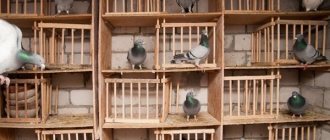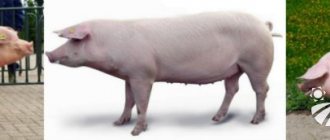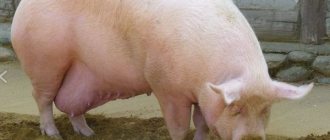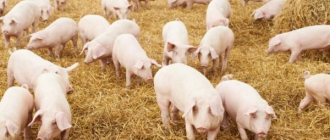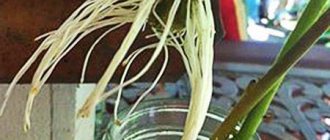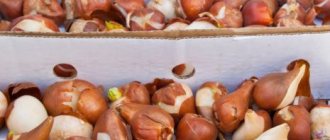In the summer, keeping pigs, like other farm animals, is not so difficult, but in the winter, any animal requires slightly different housing and nutrition conditions. Don’t think that you will need enormous efforts to keep pigs; it will be enough to familiarize yourself with the most basic rules and you can avoid many troubles. There are different ways to keep pigs in winter:
- indoors;
- in the hangar;
- in a pen on the street.
When choosing a more convenient method of keeping for yourself, you need to take into account not only your wishes, but also the characteristics of pig breeds and the weather conditions of your region. Some breeds are more delicate, so they need more comfortable conditions, otherwise they can suffer from respiratory diseases and even pneumonia. And even if you keep fairly unpretentious breeds of pigs that are adapted to harsher climatic conditions, it is still best to keep them indoors if possible.
Keeping indoors
If you decide to keep your livestock in a pigsty, then you have every chance to protect the animals from bad weather, as well as control their living conditions as much as possible. Indoors, pigs must have an open area where they can walk. During the cold season, pigs will eat a lot more food, due to the fact that they need a lot of energy to heat themselves. But food not only provides energy, but is also stored as additional fat. It all depends on the feeding technology and the goals set by the livestock breeder. For lard fattening, it is recommended to create conditions that ensure the least possible mobility of animals; for meat fattening, on the contrary, if the animals have access to an open area and they regularly walk there, this will not allow them to gain much fat.
When a pig is wintering in a pigsty, the work associated with care increases, since the bedding will need to be changed quite often. This is done to ensure that the animals are always clean and dry; the thicker the bedding, the more it insulates the livestock from the cold that can seep through the floor. It is also worth considering the number of pigs in the room, each of them generates heat, and the more animals in the pigsty, the warmer it will be.
When keeping pigs indoors, you must first take care of the absence of drafts and the arrangement of supply and exhaust ventilation. Animals are not so much afraid of the cold as they are of drafts, especially in combination with dampness. Ensuring normal air exchange in the room is an excellent prevention of respiratory diseases.
Choosing a pig breed for breeding
If the choice is made in favor of fattening, then you should take into account the division of all breeds into:
- meat;
- sebaceous;
- bacon
Meat products quickly gain muscle mass and the meat yield is 60–65%.
Find out more about the features of choosing meat breed pigs.
Meat includes:
- English large white;
- Cornish black;
- landrace;
- Duroc.
Sebaceous ones are characterized by a thick layer of fat in the carcass, which is built up by an appropriate diet.
The most famous representatives of this species:
- Mirgorodskaya;
- Belarusian black-and-white;
- North Caucasian.
The tender meat of bacon pigs is permeated with layers of fat, which allows you to make bacon slices from it.
These breeds are considered:
- Estonian bacon;
- Korean;
- pig pockets.
Contents in the hangar
Placing pigs in a hangar, in other words - cold keeping, implies living of animals in frame buildings covered with an awning. Recently, this method has gained more and more supporters. At the same time, it also has plenty of opponents, primarily due to the increase in feed consumption per unit of weight gain.
When organizing cold storage, it is extremely important that the awning on the metal frame is pulled very carefully and that there are no slightest cracks or drafts. Also, in such a hangar, the layer of bedding should be larger than usual in order to protect the pigs from the cold as much as possible. Cold keeping involves the use of deep, permanent bedding, the rotting processes in the thickness of which serve as an additional source of heat for animals.
However, if a sow plans to farrow in such a hangar, then inside it it is necessary to build houses with a cage attached to it so that the piglets can be fed. Or transfer the animal to a warmer room before farrowing.
But even despite the fact that your pigsty is assembled correctly, the awning is perfectly tensioned, and the amount of bedding is sufficient, you still need to take into account the fact that the pigs living in it will spend much more energy on heating themselves than those living in premises. In this regard, the food of such animals must be nutritious, in the right quantity and as balanced as possible.
In hangars, the bedding is not changed; it is removed only after three or four months, depending on the period of fattening of the pigs, and after that a new one is laid. There is an opinion that such living conditions are not optimal, since in order for pigs to warm themselves, they need to be fed more, which entails additional costs. In addition, fungi can settle in the bedding, and if at least one of the pigs gets a fungal or infectious disease, it can be transmitted to the rest of the animals.
At the same time, some farmers claim that if all the rules are followed when building a tent hangar, then keeping pigs in it, with the exception of sows and piglets, shows good results, and the animals become more hardened and less susceptible to various diseases.
Feeding ration
The norm for average daily weight gain is considered to be 650 g; at the age of 6 months, the pig reaches 100-120 kg. Costs per 1 kg of weight should not be more than 4 feed units.
Piglets move into the category of “adult pigs” upon reaching a weight of 40-50 kg. Nutrition is selected depending on the purpose of the animal. Let's consider the nutritional features for different categories of pigs.
Feeding boars
When fattening boars, it is important to control their condition - emaciated or obese individuals lose sexual activity and productivity. During the breeding season, animals need to increase the amount of feed, as their metabolism accelerates.
If boars are limited in copulation, nutritional standards are reduced by 10-20%. The volume of dry food is measured based on 100 kg of live weight. Growing children receive – 1.6 kg, adults – 1.4 kg. The basis of the menu is cereals, cake, meal, meat and fish waste, peas.
An approximate daily ration for an adult boar is given in Table 14.
Table 14
| Feed, kg | During the mating period | In a non-random period | ||
| in summer | in winter | in summer | in winter | |
| Concentrate mixture | 2,9 | 2,3 | 1,5 | 1,1 |
| Peas broad beans | 0,9 | 0,8 | 0,4 | 0,4 |
| Combisilos | — | 4 | — | 4 |
| Herbal meal | — | 0,5 | — | 0,5 |
| Return | 2,5 | 3 | 1 | 1 |
| Grass | 3 | — | 4 | — |
| Chalk, g | 20 | 40 | 15 | 30 |
| Salt, g | 45 | 50 | 35 | 40 |
| Number of feed units in the diet | 4,9 | 4,9 | 3,8 | 3,8 |
| Digestible protein, g | 690 | 690 | 420 | 420 |
Feeding suckling sows
The farrowing sow, immediately after the appearance of the piglets, is given plenty of warm water. The first feeding is after 10-12 hours. She is fed liquid mash, which is prepared from:
- oatmeal and wheat bran;
- chalk and table salt - 20-30 g each;
The second feeding is after 5-6 hours. The daily norm is increasing gradually. The sow is transferred to the full feed allowance only by 6-8 days. During the first 10-20 days, the pig is fed liquid feed to enhance lactation. At the end of the first suckling period, the queen is given porridge-like food. Feeding suckling queens - twice a day.
During the suckling period, it is recommended to give per day:
- legume hay flour – 2-3 kg;
- potatoes – 3.5 kg;
- root vegetables – 4-5 kg;
- silage – 2-3 kg;
- concentrates – 3-5 kg;
- return – 2-4 l.
An approximate diet for lactating sows is given in Table 15. Data for a pig weighing 180-200 kg, nursing a dozen piglets.
Table 15
| Indicators, kg | Winter period | Summer period | ||
| Potato concentrate | Concentrated root vegetable | Concentrated | ||
| Barley | 2,5 | 0,4 | 1,2 | 1,7 |
| Wheat | 0,6 | 3 | 2,4 | — |
| Corn | — | — | — | 2/3 |
| Peas | 0,2 | 0,4 | 0,4 | 0,2 |
| Herbal meal | 0,7 | 0,7 | 0,7 | — |
| Sunflower meal | 0,4 | 0,2 | 0,3 | 0,3 |
| Fish meal | 0,2 | 0,2 | 0,1 | 0,2 |
| Return | 1 | 1 | 1 | 1 |
| Steamed potatoes | 5 | — | — | — |
| Semi-sugar beets | — | 6 | — | — |
| Green mass of legumes | — | — | — | 6 |
| Combisilos | — | — | 3,7 | — |
| Indicators, g | ||||
| Precipitate | 57 | 59 | 71 | 44 |
| Salt | 30 | 30 | 30 | 30 |
| Premix | 60 | 60 | 60 | 60 |
| Feed units | 6,8 | 6,8 | 6,8 | 6,8 |
| Digestible protein | 764 | 764 | 764 | 761 |
Feeding single and pregnant sows
Their fertilization, fertility and health of newborns depend on the quality of feeding of single queens. It is important to provide a high-quality diet, starting with preparation for mating. The egg matures in 20-22 days. That is, preparation of the uterus should begin a month before mating.
The diet of single queens should include:
- food rich in protein - fish waste, small fish (serrat), various seafood, flaxseed cake;
- concentrated feed;
- clover hay;
- silage;
- potato;
- carrot.
In the second half of pregnancy, they begin to provide feed of the highest quality. Towards the end of the period, the amount of roughage and succulent food is gradually reduced. Half a month before the birth of piglets, the pig is fed skim milk - 0.5-1 liters. 3-5 days before the interview they stop giving milk. The amount of feed is reduced to 50% of the diet. Diets for single and pregnant sows - in the first and second half of pregnancy - are given in Tables 16 and 17, respectively.
Table 16
| Feed, kg | winter | summer | ||
| Uterus up to 2 years (150 kg) | Uterus over 2 years old (200 kg) | Uterus up to 2 years (150 kg) | Uterus over 2 years old (200 kg) | |
| Grain mixture | 1,6 | 1,1 | 2 | 1,8 |
| Flaxseed cake | 0,2 | 0,3 | 0,1 | 0,2 |
| Sugar beets, potatoes | 2 | 2 | 6 | 5 |
| Combisilos | 4 | 4 | — | — |
| Herbal meal | 1 | 1 | — | — |
| Chalk, g | 10 | 10 | 20 | 10 |
| Salt, g | 40 | 35 | 40 | 40 |
| Feed units in the diet | 3,8 | 3,4 | 3,8 | 3,4 |
| Digestible protein, g | 430 | 375 | 400 | 365 |
Table 17
| Feed, kg | winter | summer | ||
| Uterus up to 2 years (150 kg) | Uterus over 2 years old (200 kg) | Uterus up to 2 years (150 kg) | Uterus over 2 years old (200 kg) | |
| Grain mixture | 2,2 | 1,8 | 2,6 | 2,4 |
| Soybean cake | 0,4 | 0,3 | 0,3 | 0,3 |
| Sugar beets, potatoes | 2 | 2 | 5 | 3,5 |
| Combisilos | 4 | 4 | — | — |
| Herbal meal | 0,5 | 0,5 | 0,5 | 0,5 |
| Chalk, g | 45 | 20 | 45 | 40 |
| Salt, g | 45 | 40 | 45 | 40 |
| Feed units in the diet | 4,4 | 3,9 | 4,4 | 3,9 |
| Digestible protein, g | 490 | 425 | 490 | 440 |
Read more about feeding pregnant sows here.
Outdoor pen keeping
Keeping pigs in a pen located outside also refers to cold keeping, but this method may only be suitable for more southern regions, where winters are mild and temperatures rarely reach negative values. With this approach, a canopy is built over the pen (or part of it), allowing the animals to shelter during bad weather.
However, it is strictly prohibited to keep piglets and sows in such pens.
Animals must be provided with a platform under a canopy on which they sleep. If possible, try to raise the platform above the ground, for which railroad sleepers or any other strong supports are perfect. If the bottom of the platform does not touch the ground, then it will always be dry, since rainwater will not be able to seep through the floor. The pen itself must be built on an elevated area, since if it is in a lowland, there is a risk of flooding.
Since cold housing is not suitable for all pigs and some of them require a special approach, it is recommended to pay special attention to the features of housing:
- pregnant sows;
- suckling young animals;
- boars.
In order for all pigs to feel as comfortable with the onset of cold weather as in the warm season, it is necessary to think about this before the onset of winter. But no matter what conditions you decide to keep pigs in, you need to know that the most optimal temperature for them should be within eighteen degrees Celsius.
Hypothermia can threaten animals with serious illnesses, which sometimes even lead to death. And it is very important to remember that the quantity and quality of bedding plays a very important role in maintaining heat.
Conditions for buildings
During the cold season, piglets are placed in insulated pigsties with wooden flooring. The breeder needs to ensure that there are no drafts in such premises, that there is constant good lighting, and that sanitary and hygienic standards are strictly observed. It should be remembered that temperature fluctuations, lack of light, dirt, poor diet, and extraneous noise in the barn can lead to illness in young piglets or slower weight gain. Also, if these rules are violated, problems may arise with feeding young animals, since the sow may have a decrease in the amount of excretions necessary for feeding piglets.
Temperature and heating
In winter, the temperature in a barn with pigs can range from +14 to +18 degrees. It is undesirable for it to fall below +13 degrees or rise above +20 degrees, otherwise this will lead to colds in pigs and may have a bad effect on the rate of weight gain in piglets. This rule applies to barns that house piglets that have already been weaned from the sow.
In the room with newborn piglets, the air temperature should be higher than in the rest of the pigsty. Here it cannot fall below +18 degrees. It can be maintained using special lamps or a heater.
To maintain the desired temperature level, the pigsty can be insulated. To do this you should:
- make additional plank flooring 20 cm higher than the “real” floor;
- cover the floor with thick straw bedding;
- insulate ventilation openings with straw (if any);
- install heat lamps in pens with small piglets.
In cold regions, it is also recommended to additionally line the pigsty with boards for the winter, covering them with sawdust, moss or straw. This will allow you to maintain the desired temperature in the room without installing a heating system in it.
Humidity
Pigs are very picky about the level of humidity in the pigsty in winter. It should be at the level of 75%-80%, no more. Low humidity, as well as its increased value, can negatively affect the health of piglets and sows. In order to strictly follow the recommendations for this parameter, it is recommended to install a special device for measuring humidity in the pigsty.
You can read more about drinking bowls for pigs at the link.
To regulate the level of humidity in the room, you can use humidifiers or heaters that dry the air as necessary. But ventilation cannot be used to control this parameter: drafts in a pigsty can lead to colds in both the sow and small piglets.
Hygiene standards for piglets, how it should be, how to maintain a pigsty
In order not to encounter infectious diseases in piglets, the breeder needs to take care of maintaining hygiene standards in the pigsty. They provide:
- Placing piglets weaned from the sow in small groups of 10 to 25 individuals. According to standards, for each pig weighing up to 70 kilograms there must be at least 0.7 square meters in the pen.
- Arrangement of special drinkers and feeders in each pen. In winter, water and food in feeders need to be changed twice a day.
- Placement of fresh straw flooring in the machines. This flooring must be changed regularly.
- Daily cleaning of machines from excrement.
Read about how to properly make a pig feeder with your own hands in this article.
After weaning from the mother, there can be from 10 to 25 piglets in the pigsty
To make caring for piglets easier, pens can have a slatted floor with a slope. It is recommended that the width of the slats in such a floor be at least 5 cm, and the width of the slots no more than 2 cm. Compliance with such standards will avoid injury to the piglets and will help maintain cleanliness in the pens.
Maintenance of pregnant sows
As farrowing approaches, sows become increasingly vulnerable and susceptible to low air temperatures. The greatest danger is udder hypothermia.
Keeping the sow before farrowing and immediately after it in cold conditions or on damp bedding is unacceptable, since it is fraught with the development of mastitis, which in pigs is very difficult to treat, and you risk losing the entire offspring produced.
Also, both before farrowing and immediately after it, the sow should not be sent for a walk. Born piglets all the more need warmth and plenty of dry bedding, otherwise the risk of hypothermia in newborns is very high. Only warm water should be poured into the sow's drinking bowl, and the closest attention should be paid to the quality and quantity of the feed given to the sow, since the quality and quantity of the sow's milk and, accordingly, the health and growth of the piglets depend on this.
Boar management
The conditions in which boars are kept, as well as the quality of their feeding, have a direct impact on the quality of their sperm. Facilities for keeping boars should always be dry, warm and clean; the temperature in them should not fall below sixteen degrees Celsius. Feeding should be complete, and for better productivity, boars should be allowed outside for short walks.
Unlike fattening young animals, active exercise for the producer is an indispensable condition for his high-quality work.
Features of feeding pigs in winter
Winter feeding of pigs has its own characteristics, which are not always associated with cold weather. Firstly, most often at this time the livestock is in the final stage of fattening, and it is during this period that sows are often inseminated. Secondly, the range of feeds and the structure of the diet itself changes.
Therefore, feeding must be taken seriously, taking into account the needs of sows, boars, piglets, young animals and adult pigs. In cold weather, food should always be complete and contain sufficient nutrients and minerals.
It is advisable that adult pigs receive daily:
- concentrates;
- meadow hay;
- succulent feed;
- fish and meat waste;
- roughage;
- vegetable and fruit peelings;
- salt;
- warm water.
It is necessary to add mineral feed, as well as chalk and ash, to the diet of sows, since when they are preparing for farrowing, they need special feeding. Sow's milk lacks some macroelements, as well as iron in the amount that babies need. In order to avoid various diseases, including rickets, in young animals that are already feeding on their own, coal, chalk, fish oil, bone meal and other components are added to their feed.
It is highly advisable to vitaminize livestock using injections during the winter period. It is best to discuss the timing of this procedure, the choice and dosage of medications with your veterinarian.
Farrowing of adult pigs
In the winter season, the breeder needs to prepare more carefully for farrowing. As soon as he notices signs of impending birth in the pig (restlessness, refusal to eat), it should be placed in a separate enclosure. You should also limit the sow to walks in the fresh air, protect her from drafts and set the temperature in the pen with the pig at +15 degrees. For this it is best to use special lamps.
At the beginning of farrowing, the pig usually calms down, lies on its side, and experiences contractions and characteristic discharge. A breeder who notices such symptoms in an animal needs to prepare antiseptic materials, gloves, scissors, iodine, ropes, diapers, buckets of clean water, warm and cold. Piglets will appear after each attempt along with amniotic fluid. After birth, piglets must be immediately brought to the mother's nipples. You can read about farrowing of Vietnamese pigs here.
When a baby appears, a breeder needs to act like this:
- It is necessary to clean the piglet of films, be sure to wipe the animal’s nose and mouth of mucus so that it does not suffocate.
- If the animal does not show signs of life, it needs to actively massage its chest, open its mouth and blow hard into it. In 80% of cases this technique helps. If it does not give the desired result, the animal must be dipped alternately in cold and warm water several times.
- Next, you need to cut the umbilical cord with scissors at a distance of a few centimeters from the abdomen. The wound must be cauterized with iodine or brilliant green.
- After this, the pig should be placed in a warm place: in a specially prepared box or under a lamp.
- During the first 45 minutes of a piglet's life, it must be placed under the mother's nipples. If he does not eat colostrum during this period, in the future he will constantly be sick and gain weight poorly.
After giving birth, you must take the afterbirth from the enclosure and bury it. One thing to remember is that if the pig eats it, it may then start eating live piglets.
If you don’t know anything about childbirth, it is advisable to invite a veterinarian. The first birth is usually more difficult for the animal, and it may require medical assistance.
Walking pigs in winter
When keeping pigs indoors, there is no point in walking them every day, but periodic walks on sunny days will have a good effect on their health and immunity. Also, walks help normalize the functioning of the digestive tract, and the sun's rays will be an excellent prevention of the development of rickets in young animals.
It is best to place the walking yard on the southern, warmer side of the barn and, if possible, protect it from strong winds.
In case the weather turns bad, it is necessary to arrange a canopy under which the animals can hide. On relatively warm days, feeding pigs can be done outside, taking care to ensure that feed and water do not freeze.
Bacon fattening
Bacon (meat) pigs are kept for fattening. This means that animals are kept until they reach a weight of 100-120 kg, but no more. At the same time, the pig should not be thin. The degree of fattening can be determined by measuring the thickness of the sebaceous layer on the ridge. The norm for meat is considered to be a layer thickness of up to 4 cm.
Daily weight gain is 600-700 g. The menu must include:
- grain waste;
- bone flour;
- sugar beet;
- potato;
- food waste.
Their volume must be at least 50% of the total mass of products on the menu.
On farms, the cultivation of meat breeds is streamlined, established feeding standards are observed, but in everyday life it is more difficult to raise a pig with relatively lean meat. It all depends on what the pigs are fed at home. It is important to maintain a balance of vitamins and minerals, and the main thing is to provide the animal with proteins. The norm at the beginning of fattening is 130 g of protein per day, and for adult animals the amount of protein is reduced to 100 g per day. Meat pigs also need root vegetables and legumes.
